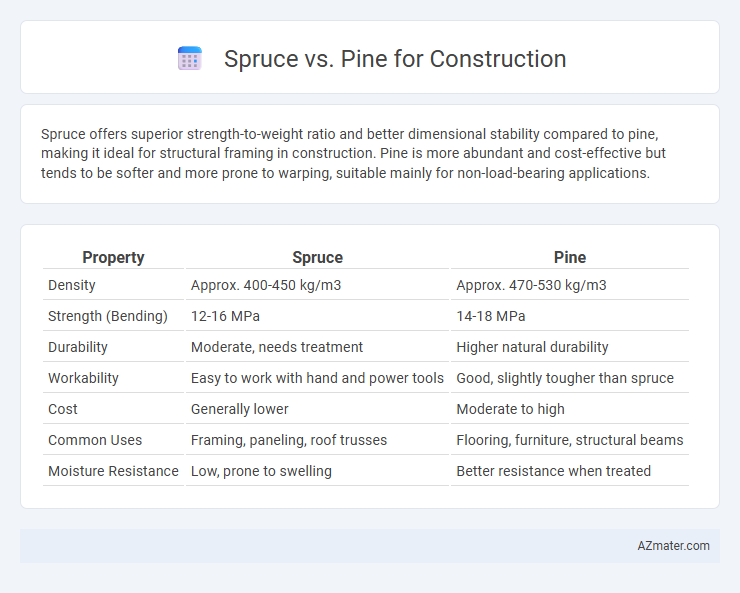Spruce offers superior strength-to-weight ratio and better dimensional stability compared to pine, making it ideal for structural framing in construction. Pine is more abundant and cost-effective but tends to be softer and more prone to warping, suitable mainly for non-load-bearing applications.
Table of Comparison
| Property | Spruce | Pine |
|---|---|---|
| Density | Approx. 400-450 kg/m3 | Approx. 470-530 kg/m3 |
| Strength (Bending) | 12-16 MPa | 14-18 MPa |
| Durability | Moderate, needs treatment | Higher natural durability |
| Workability | Easy to work with hand and power tools | Good, slightly tougher than spruce |
| Cost | Generally lower | Moderate to high |
| Common Uses | Framing, paneling, roof trusses | Flooring, furniture, structural beams |
| Moisture Resistance | Low, prone to swelling | Better resistance when treated |
Introduction to Spruce and Pine in Construction
Spruce and pine are two of the most commonly used softwoods in construction, valued for their strength-to-weight ratios and workability. Spruce wood, known for its light color and fine, even texture, offers excellent structural performance, making it ideal for framing, beams, and joists. Pine, with its higher resin content and distinct grain patterns, provides durability and resistance to decay, often utilized in flooring, paneling, and cabinetry.
Botanical and Wood Characteristics
Spruce (genus Picea) and Pine (genus Pinus) are both coniferous softwoods widely used in construction, but they differ botanically in needle arrangement and cone structure; spruce needles are single and four-sided, while pine needles group in clusters of two to five. Wood characteristics of spruce include a lighter color with uniform grain, lower density around 400-480 kg/m3, and excellent stiffness-to-weight ratio, making it ideal for structural framing and soundboards. Pine wood tends to have a higher density of 500-600 kg/m3, more resin canals, and a pronounced grain pattern with knots, offering greater durability but requiring treatment for resistance to decay and insect damage in construction applications.
Strength and Durability Comparison
Spruce wood offers high strength-to-weight ratio, making it ideal for structural applications where lightweight and load-bearing capacity are essential, while pine tends to have a higher resin content that can affect its long-term durability. Pine is generally more resistant to decay and insect damage compared to spruce, making it a better choice for outdoor and treated wood projects. For construction purposes, spruce provides consistent strength for framing and beams, whereas pine's enhanced durability benefits roofing and siding exposed to harsher environmental conditions.
Workability and Ease of Use
Spruce offers superior workability in construction due to its light weight and consistent grain, making it easy to cut, shape, and fasten. Pine, while generally more resinous, can pose challenges during machining but provides good nail and screw holding capacity. Both woods are commonly used, but spruce is preferred for precision work and ease of handling on job sites.
Appearance and Grain Differences
Spruce wood features a light yellow to pale white color with a fine, even grain that creates a smooth, uniform appearance ideal for modern, clean-lined construction projects. Pine exhibits a warmer, creamier tone with more visible knots and swirling grain patterns, offering a rustic, textured look favored in traditional or country-style designs. The grain of spruce is generally straighter and less prominent than pine's, making spruce better suited for finishes requiring a sleek, polished aesthetic.
Resistance to Decay and Insects
Spruce offers moderate resistance to decay and insects but generally requires treatment for extended durability in construction. Pine is naturally more resinous, providing better resistance to insect attacks and decay, especially when using heartwood from species like Southern Yellow Pine. Choosing pine can reduce maintenance costs and improve longevity in environments prone to moisture and pests.
Cost and Availability
Spruce offers a lower cost and higher availability compared to pine, making it a preferred choice for budget-conscious construction projects. Pine is often more expensive due to slower growth rates and limited regional supply, which impacts affordability for large-scale building. The widespread availability of spruce in North America and Europe ensures steady supply chains and cost-effective procurement for structural applications.
Environmental Impact and Sustainability
Spruce and pine are both popular softwoods used in construction, but pine generally offers higher sustainability due to faster growth rates and widespread availability, reducing deforestation pressures. Spruce has a slightly lower carbon footprint during processing and transportation, making it favorable for projects prioritizing local sourcing and reduced emissions. Both woods are renewable, but responsible forest management and certification like FSC or PEFC are critical for minimizing environmental impact in construction materials.
Best Applications for Spruce vs Pine
Spruce is ideal for interior construction, such as framing, paneling, and trim, due to its lightweight nature and smooth finish, which allows for easy handling and aesthetic appeal. Pine, known for its strength and durability, is better suited for structural applications like flooring, roofing, and outdoor projects where resistance to wear and environmental factors is crucial. Choosing spruce for visible, detailed work and pine for load-bearing or exterior uses optimizes performance and longevity in construction projects.
Choosing the Right Wood for Your Construction Project
Spruce offers a lightweight, straight-grained option ideal for framing and structural purposes, known for good workability and moderate strength. Pine, typically denser with higher resin content, provides durability and resistance to decay, making it suitable for both indoor and outdoor construction elements. Selecting between spruce and pine depends on project requirements for strength, flexibility, weather resistance, and finishing preferences.

Infographic: Spruce vs Pine for Construction
 azmater.com
azmater.com